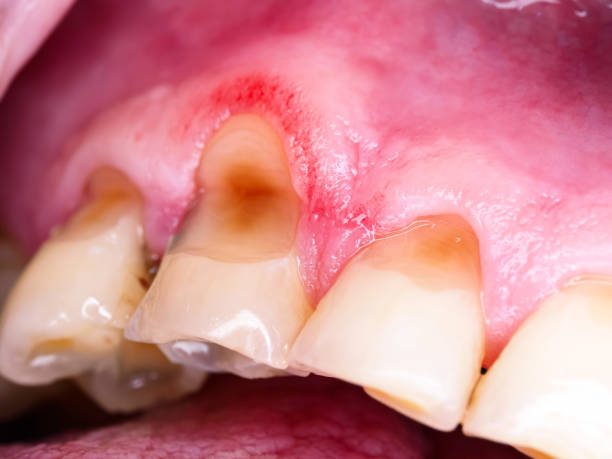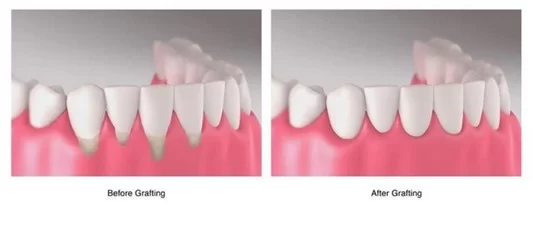What is Gum Disease?
Gum disease, also known as periodontal disease, is a condition in which the gums become infected and inflamed. This can lead to a number of problems, including tooth loss. Gum disease is caused by a build-up of plaque on the teeth, which leads to the growth of harmful bacteria. These bacteria can cause the gums to become red, swollen, and bleed easily. If left untreated, gum disease can progress and damage the supporting structures of the teeth, leading to tooth loss. It is important to practice good oral hygiene, including brushing and flossing regularly, to prevent gum disease.

Types of Gum Disease
Gingivitis is a mild and early form of gum disease that can cause gum redness, swelling, and bleeding. Most often, gingivitis occurs due to poor oral hygiene, microbial plaque, and tartar buildup. Professional treatment can reverse the condition.
Periodontitis is a more severe form of gum disease in which gingivitis has worsened and advanced, leading to an inflammatory response that destroys bone and tissues.
During this inflammatory process, the gums begin to separate from the teeth. This causes spaces called pockets to develop, which in turn trap bacteria and lead to infection.
As a result, tooth loss and bone damage can occur.

What is Periodontal Surgery or Gum Surgery?
Sometimes, periodontal surgery may be needed to treat certain gum diseases and conditions, such as gingivitis or periodontitis. This type of surgery is commonly known as gum surgery.
The procedure aims to treat the gum disease and any damage it may have caused by:
- Repairing damaged bones and tissues caused by microbial plaque
- Preventing more bone loss and tooth loss
- Reducing gum gaps between teeth, known as black triangles
- Reshaping the jaw bone to lower the risk for bacterial growth in bone crevices
- Eliminating bacteria and infection
What Will Happen During Gum Surgery?
Before a person has a gum surgery, Dr. Dowlatshahi will perform a pre-operative exam to make sure it is safe to have surgery.
During this exam, Dr. Dowlatshahi will likely:
- Take a medical history review and do an exam
- Examine the teeth, mouth, and jaw to check for stability and health
- Check for any infections, abscesses, or other lesions that could make healing from surgery more complicated
- Discuss the risks and benefits of the operation, and receive permission or consent to move forward with the surgery
WHAT HAPPENS DURING SURGERY?
Depending on the type of procedure, a range of things may take place.
Most gum surgery procedures take around 1 hour to complete.
The surgery only involves the use of a local anesthetic to numb the gums. The injection of the numbing medication can be mildly uncomfortable.
During the procedure, the dental surgeon uses sterile equipment, including instruments and drapes, to lower the risk of infection.
After making small incisions or cuts along the gum line, Dr. Dowlatshahi will lift the gums away from the teeth.
In some cases i use Laser for doing this procedure so there is no incision and flap reflection and sometimes no need for sutures.
This allows Dr. Dowlatshahi to see the roots better so that they can remove and clean away any tartar, plaque, or infection, in many cases i use Laser for doing this procedure so sometimes there is no incision and flap reflection and sometimes no need for sutures.
Following this deep cleaning, the dental surgeon can perform other procedures, such as gum reshaping, bone regeneration procedures, or other planned procedures.
Once the planned dental surgery is complete, the surgeon will stitch the gums back into place, using fine thread stitches. Dr. Dowlatshahi will remove the stitches 7 to 10 days after surgery.
RECOVERY
Following any dental procedure, Dr.Dowlatshahi will provide detailed instructions on how to achieve the best possible recovery. Recovery times will depend on the extent of the procedure taking place
Typically, people will require pain relief medications in the days after gum surgery. Again, Dr. Dowlatshahi will talk to the person about any recommended drugs before they leave the office or surgical center.
Dr. Dowlatshahis may also recommend:
- using an antiseptic mouthwash to keep the area clean and to avoid infection
- avoiding strenuous exercise
- eating soft foods in the days following surgery
Dr. Dowlatshahi will schedule an appointment to return to the office for 1 week time. During this appointment, the surgeon will check how the gums are healing and, if required, remove any stitches.
A person’s gums will look and feel different after surgery. The gums and teeth will heal, tighten, and become firmer and stronger. Some people may have tooth sensitivity to hot or cold temperatures and may find relief by using desensitizing toothpaste.
Dr. Dowlatshahis will discuss a follow-up schedule to maintain good oral health in the future.
Please see Post-op instruction.
TYPES OF SURGICAL PROCEDURES
Which kind of surgery a dental surgeon performs depends on the type and severity of the gum disease.
Before surgery, a dental surgeon might give the gums a deep clean. One procedure known as deep scaling can remove tartar and bacteria from teeth and gums.
Another procedure known as root planing can smooth the surfaces of the roots of the teeth, meaning that there are fewer places for tartar and bacteria to build up. This procedure also removes any tartar that is on the root.
Deep scaling and root planing usually occur at the same time.
FLAP SURGERY
Flap surgery is especially helpful for people who have tartar deposits in deep pockets. The procedure involves lifting the gums off of the teeth to remove tartar buildup.
After the surgeon has cleaned the area and removed the tartar, they will stitch the gums into place to fit around the teeth. Sometimes, the bone may require reshaping during this procedure.
Laser Therapy: LANAP, Laser-Assisted New Attachment Procedure
It is a surgical laser procedure designed for the treatment of periodontitis through regeneration rather than resection. The LANAP procedure is a protocol that deals with inflammation, the infectious process, occlusion, tooth mobility, and an osseous component. It is a rather simple, but elegant, protocol that tips the scales in favor of periodontal regeneration. Dr. Dowlatshahis use it to reduce the size of pockets and restore damaged connective tissue.
Even patients who have traditionally avoided dental treatment or experienced traditional surgery in the past accept LANAP treatment. They are seeking an alternative to traditional surgery and are familiar and comfortable with the use of lasers for LASIK treatment for their eyes. Thus, they consider laser treatment for periodontal disease a viable alternative. Clinically, what becomes immediately apparent postoperatively is minimal discomfort, shrinkage of swollen, puffy gums, and reduction of bleeding.
After the procedure, patients can see that the tissues feel and look healthier. Since LANAP treatment is not a cut-and-sew procedure, no native tissues are injured; the recession associated with traditional surgery is not present. Consequently, the patients do not have root sensitivity or teeth that appear longer.

TISSUE GRAFTING
A lowered gum line, known as gum line recession, is caused by the loss of gum tissue and may require soft tissue grafting to reduce the risk of further damage.
During this procedure, a dental surgeon typically removes tissue from one part of the body and re-attaches it to the area where the gum has receded. The tissue often comes from the roof of the mouth.
Tissue grafting not only reduces the risk for further damage but also covers any exposed roots.
BONE GRAFTING
When the bone that surrounds the root of the tooth is damaged or destroyed, a person may need a bone graft. This procedure involves replacing the damaged bone with new bone. This bone may be the person’s bone, a manufactured bone, or donated bone.
The goal of bone grafting is to hold the tooth in place and help it to regrow.
During this procedure, a dental surgeon will place a small piece of collagen membrane material between a person’s bone and gum tissue.
The material prevents the gum from growing into space which is filled with bone graft allowing the bone to regrow without any gum tissue interference.
